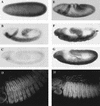Functional and regulatory interactions between Hox and extradenticle genes
- PMID: 9436985
- PMCID: PMC316439
- DOI: 10.1101/gad.12.2.261
Functional and regulatory interactions between Hox and extradenticle genes
Abstract
The homeobox gene extradenticle (exd) acts as a cofactor of Hox function both in Drosophila and vertebrates. It has been shown that the distribution of the Exd protein is developmentally regulated at the post-translational level; in the regions where exd is not functional Exd is present only in the cell cytoplasm, whereas it accumulates in the nuclei of cells requiring exd function. We show that the subcellular localization of Exd is regulated by the BX-C genes and that each BX-C gene can prevent or reduce nuclear translocation of Exd to different extents. In spite of this negative regulation, two BX-C genes, Ultrabithorax and abdominal-A, require exd activity for their maintenance and function. We propose that mutual interactions between Exd and BX-C proteins ensure the correct amounts of interacting molecules. As the Hoxd10 gene has the same properties as Drosophila BX-C genes, we suggest that the control mechanism of subcellular distribution of Exd found in Drosophila probably operates in other organisms as well.
Figures









Similar articles
-
The control of trunk Hox specificity and activity by Extradenticle.Genes Dev. 1999 Jul 1;13(13):1704-16. doi: 10.1101/gad.13.13.1704. Genes Dev. 1999. PMID: 10398683 Free PMC article.
-
Activity regulation of a Hox protein and a role for the homeodomain in inhibiting transcriptional activation.EMBO J. 1999 Jan 4;18(1):198-211. doi: 10.1093/emboj/18.1.198. EMBO J. 1999. PMID: 9878063 Free PMC article.
-
The Homothorax homeoprotein activates the nuclear localization of another homeoprotein, extradenticle, and suppresses eye development in Drosophila.Genes Dev. 1998 Feb 1;12(3):435-46. doi: 10.1101/gad.12.3.435. Genes Dev. 1998. PMID: 9450936 Free PMC article.
-
Unraveling cis-regulatory mechanisms at the abdominal-A and Abdominal-B genes in the Drosophila bithorax complex.Dev Biol. 2006 May 15;293(2):294-304. doi: 10.1016/j.ydbio.2006.02.015. Epub 2006 Mar 20. Dev Biol. 2006. PMID: 16545794 Review.
-
Homeodomain proteins. Cooperating to be different.Curr Biol. 1995 Jan 1;5(1):32-4. doi: 10.1016/s0960-9822(95)00010-8. Curr Biol. 1995. PMID: 7697343 Review.
Cited by
-
Genome-level identification of targets of Hox protein Ultrabithorax in Drosophila: novel mechanisms for target selection.Sci Rep. 2011;1:205. doi: 10.1038/srep00205. Epub 2011 Dec 22. Sci Rep. 2011. PMID: 22355720 Free PMC article.
-
Common ancestry of heterodimerizing TALE homeobox transcription factors across Metazoa and Archaeplastida.BMC Biol. 2018 Nov 5;16(1):136. doi: 10.1186/s12915-018-0605-5. BMC Biol. 2018. PMID: 30396330 Free PMC article.
-
A genetic screen of the Drosophila X chromosome for mutations that modify Deformed function.Genetics. 1998 Dec;150(4):1497-511. doi: 10.1093/genetics/150.4.1497. Genetics. 1998. PMID: 9832527 Free PMC article.
-
Sustained in vitro trigger of self-renewal divisions in Hoxb4hiPbx1(10) hematopoietic stem cells.Exp Hematol. 2007 May;35(5):802-16. doi: 10.1016/j.exphem.2007.02.013. Exp Hematol. 2007. PMID: 17577929 Free PMC article.
-
The oncoprotein E2A-Pbx1a collaborates with Hoxa9 to acutely transform primary bone marrow cells.Mol Cell Biol. 1999 Sep;19(9):6355-66. doi: 10.1128/MCB.19.9.6355. Mol Cell Biol. 1999. PMID: 10454582 Free PMC article.
References
-
- Aspland SE, White RAH. Nucleocytoplsmic localisation of extradenticle protein is spatially regulated throughout development in Drosophila. Development. 1997;124:741–747. - PubMed
-
- Brand AH, Perrimon N. Targeted gene expression as a means of altering cell fates and generating dominant phenotypes. Development. 1993;118:401–415. - PubMed
-
- Casanova J, Sanchez-Herrero E, Morata G. Identification and characterisation of a parasegment specific regulatory element of the Abdominal-B gene of Drosophila. Cell. 1986;47:627–636. - PubMed
Publication types
MeSH terms
Substances
LinkOut - more resources
Full Text Sources
Molecular Biology Databases
Research Materials
